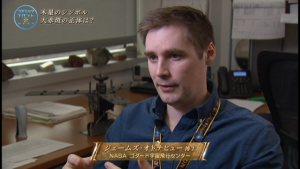The Animated Universe of James O’Donoghue
Federica Duras and Livia Giacomini (INAF) talk to the winner of the Europlanet Prize 2021 about his motivations for creating animations to communicate challenging scientific concepts and his advice on a career in planetary science.
Read article in the fully formatted PDF of the Europlanet Magazine.
Dr James O’Donoghue, winner of this year’s Europlanet Prize for Public Engagement, is proof that it’s possible to communicate science in a simple and intriguing way.
An astronomer at JAXA, Japan, James uses ground-based infrared telescopes to study Jupiter, Saturn and Uranus. His goal is simple: to paint an accurate picture of the Solar System in people’s minds and, at the same time, highlight its features in an intuitive way. His trademark is short and content-rich animations on his social media networks, which now have more than 200 million views.
His work is used around the world by teachers, in outreach events, for press releases, and in space mission descriptions. James spoke to us about his motivations and career.
Blending science with design
I’m lucky because the Universe is a cool topic. My area of expertise is in observing the uppermost parts of the atmospheres of Jupiter and Saturn.
After Earth, I’d have to say my favourite planet is either one of the ice giants, Uranus or Neptune. It used to be Saturn, but I changed my mind recently, as these freezing cold giants have so many unknowns. That’s mostly because they’ve only ever had one fly-by of a spacecraft, in the 1980s. You could say that I’m somewhat obsessed by their mysteriousness! Cassini is my favourite mission: it was a real tank of a spacecraft that orbited Saturn for 13 years and made countless discoveries.
My communication is mainly through the medium of animations or images. I think it’s the fastest way to get the information across and the most fun! I also enjoy making animations. I feel that it’s finally a way for me to have a creative outlet, especially as I was never good at more traditional forms of art. Making these animations allows me to blend science with design and share my personal view of space with people directly. In other words, I often have an idea about how some space phenomenon works in my head, and while I could explain it with words, I much prefer to show people a picture. When some of my first videos went viral, it was a bit of a shock to my system. As an introvert, as it felt like millions of people were getting a direct line into my thoughts through the animation. After getting over that, however, I started to really enjoy that connection with people. I’ve made almost 100 new videos since then. My motivations began, and continue, with the feedback received from the public and educators who have continued to be fascinated and surprised by how the universe works. Without them I might have stopped or slowed down early on.
Communicating Challenging Concepts
My favourite animation is on light speed, as it is something I have wanted to get across for a long time. Since I was a teenager I’ve realised the vast distances in space take a long time to cross, even at light-speed, and it fills me with horror to think about how distant we are from even the nearest planets. It would take at least several thousand years to get to the nearest star with our fastest spacecraft, and that’s just over 4 light-years away! The entire galaxy is 100,000 light-years across and the nearest large galaxy is 2.5 million light-years away. These distances are unthinkably vast, even travelling at light speed, and it’s been my pleasure to share this nightmare with tens-of-millions of people. I would like to explain general and special relativity, but I need time to investigate how best to teach it visually.
A Career in Space Science
The main thing I would say is that space science will keep you busy by growing dozens of different skills simultaneously. It’s not just about observing with a telescope or receiving data from a distant spacecraft, the job entails a large amount of computer programming and writing. You will not get bored and will never run out of things to do. You can certainly find the things you are best at and become the world’s expert in it quite quickly, since there are usually very few people working in each area. There are only about ten thousand astronomers and space scientists out there and we have an entire universe to cover. To speak frankly and honestly, it is a tough job in terms of career security because most of the time you will be operating on a 3-year contract approximately until getting a permanent job.
My dream job is one which combines research and outreach, with a bit of teaching. Right now, my outreach efforts are mostly done in my free time and, as my free time is getting less every year, I would like to do it as part of my job in a more serious way.
A version of ths article first appeared as a post on 8 November 2021.



